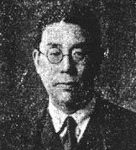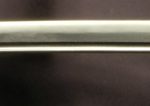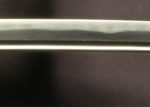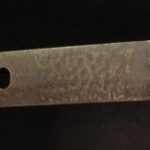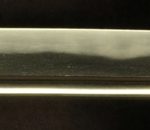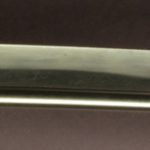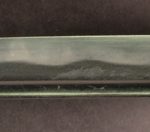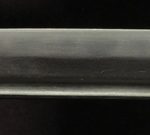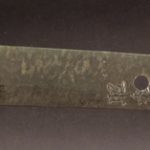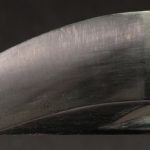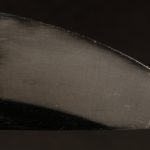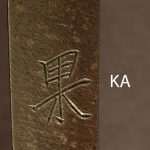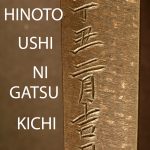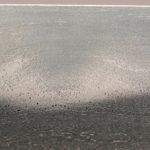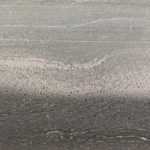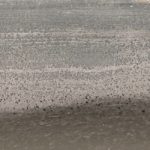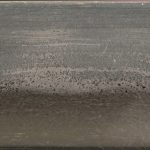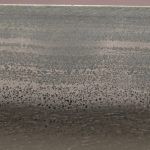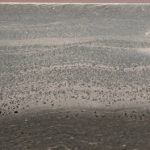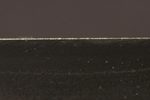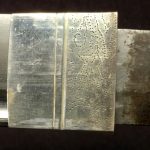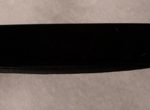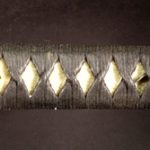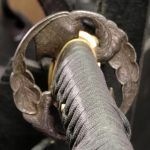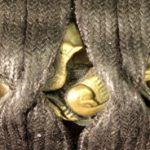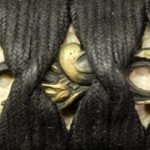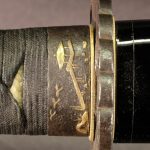SHIBATA KA / GENDAITO / SOLD
KA, SHIBATA
MEI: KA
DATE: SHOWA HINOTO USHI NI GATSU KICHI JITSU (SAKU/KAO)
NAGASA: 67.945cm (26.75″)
OVERALL: 92.71cm (36.5″)
MIHABA: 3.175cm (1.25″)
KASANE: 0.79375cm (0.3125″)
SORI: c1.111m (0.437″)
NAKAGO: UBU
MEKUGI ANA: ONE
YASURIME: KATTE SAGARI
MUNE: IORI
HADA: MUJI
HAMON: MIDARE
BOSHI: KO-MARU
HORIMONO OMOTE: BO-HI
HORIMONO URA: BO-HI
HABAKI: 1 PC. SILVER
KOSHIREA
HIGH-GRADE GENDAITO
RATED 1.5 MILLION YEN
Shibata Ka’s real name was Shibata Masataro, he was born in Akita prefecture. His family was quite wealthy which afforded him the opportunity to study many fine blades of his and other collections as well.
Ka had many passions including swordsman and martial artist, sculptor, painter, and elected official. With his passion for Japanese swords, he studied kantei under Honami Koson. Later, he established his own sword forge at his family residence and further developing his sword making skills and research into recreating the older swords of the Koto period.
Shibata Ka was known for his ability to forge a jigane which mimics these old Koto swords. One example of this relates when Shibata Ka was learning kantei from Honami Koson, he made a tanto for him. According to the story by Koson, this tanto when used in kantei is never attributed to gendaito. It was attributed by many to Shintogo Kunimitsu of the Kamakura era.
Ka is listed in the Toko Taikan, TK-32, Nihon Toko Jiten-Shinto Volume S-33, Hawley’s KA-1, Sloughs, Modern Japanese Swordsmiths, page 36, and Seskso’s Swordsmiths A-Z, page 180.
From Sesko’s:
KA (果), Shōwa (昭和, 1926-1989), Akita – “Shibata Ka kinsaku” (柴田果謹作), “Ka” (果), “Ka saku” (果作), real name Shibata Seitarō (柴田政太郎), born August 13th 1884 in Nishimonai (西馬音内) in Ugo (羽後) in Akita Prefecture where he also entertained later his forge, first he was assisting Satō Shigenori (佐藤重則) and studied later under Miyaguchi Toshihiro (宮口寿広), he tried to copy works of the Samonji school (左文字) or of Hankei (繁慶), in 1939 he made several blades on the occasion of the celebration of the 700th anniversary of emperor Gotoba ́s (後鳥羽) death, he died in March 1953, shinpin no retsu (Akihide), Special Honor Seat at the 6th Shinsaku Nihontō Denrankai (新作日本刀展 覧会, 1941)
This sword, to my knowledge has never been submitted to shinsa. The previous owner has had it in his collection for 20+ years and was not a proponent of “papers”. He realized early on that papers are only an opinion and subject to change.
I had some questions regarding the placement of the odd character at the end. I have heard this referred to it as both the term “saku” as well as it being called a Kao. In the majority of examples, I have seen, this follows the Ka character, reading either Ka Saku or Ka (Kao).
On this sword the saku/kao character is placed at the end of the nengo or date. This struck me as odd and gave me pause regarding the legitimacy of the swords mei. Then, I discovered another one done in the same manner. The Ka example shown in Sloughs (page 36) is signed and dated the same as this sword. That doesn’t mean that both are shoshin or gimei. But, it does give me a much better feeling knowing this is not some single odd example.
Blades made by Shibata Ka are rare (especially a katana) and very seldom seen for sale.
*DISCLAIMER: This is one of several consignments in which their authenticity has been questioned. I have been unable to find oshigata of Ka’s work for reference. Or not enough to form an opinion either way. There is plenty of nie and other hataraki to ensure this is a traditionally made sword and not a oil quenched showato. This would make good Iai blade and is already mounted in koshirae or might fill the need for someone on a strict budget. It is priced accordingly and the sale final.
Please do your own research and decide if this may be right for you.
Price: SOLD
If you are interested in owning this item, contact me directly at yakiba.com@gmail.com
